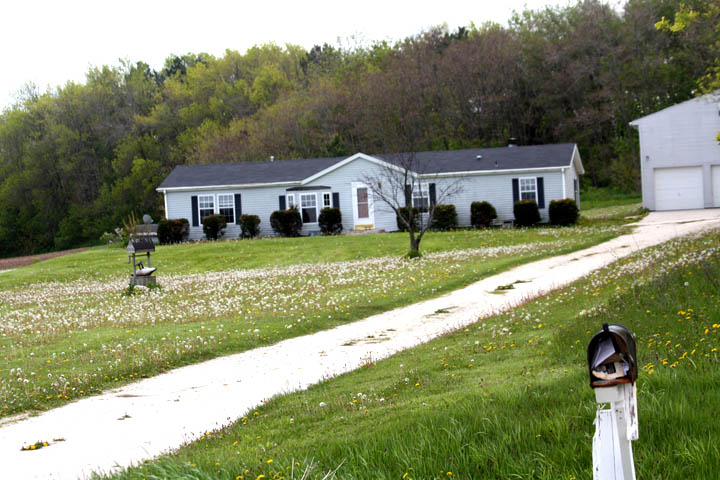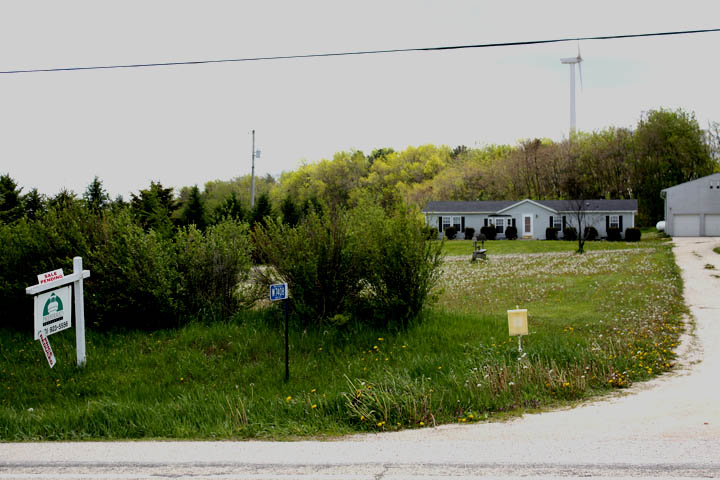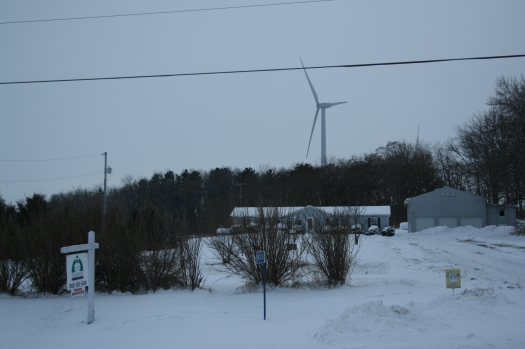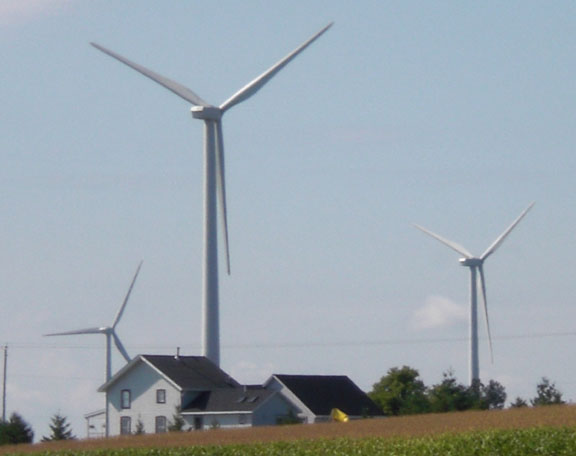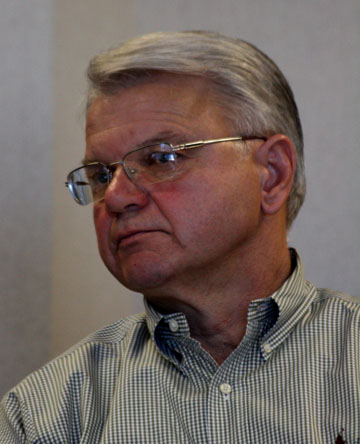“The PSC has ruled that it won’t do anything to help people who are having problems with wind farms and has basically told them to take their case to civil court”
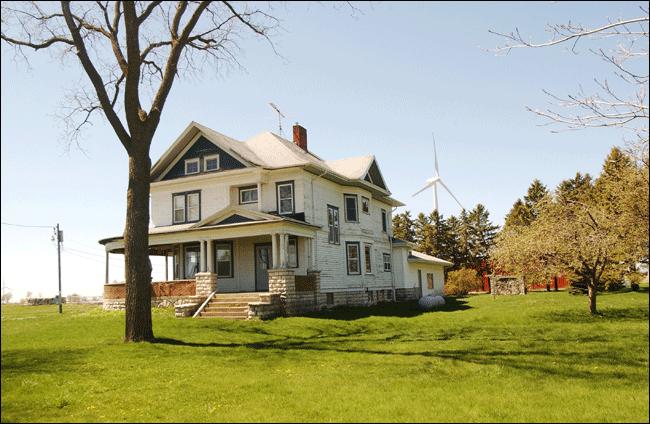 The former home of Ann and Jason Wirtz now sits abandoned near the Forward Energy Wind Center, which went online in 2008 in Brownsville. (Photo by Dave Wasinger)
The former home of Ann and Jason Wirtz now sits abandoned near the Forward Energy Wind Center, which went online in 2008 in Brownsville. (Photo by Dave Wasinger)
CLICK HERE to read about the family who once lived in this home.
PSC REJECTS OAKFIELD FAMILY'S WIND FARM CLAIM
SOURCE: Fond du Lac Reporter, www.fdlreporter.com
June 21, 2010 By Colleen Kottke,
The Public Service Commission of Wisconsin has rejected a complaint filed by an Oakfield family about the Forward Energy Wind Center.
Jason and Ann Wirtz contended that the Forward Energy Wind Center cost them their alpaca-breeding business and created such significant health problems for the family that they were eventually forced out of their home.
PSC Chairman Eric Callisto said the commission is not the proper forum for personal injury claims.
In the claim, the Wirtzes asked the PSC to reopen the Forward Wind Energy Center proceedings to hold a hearing about prior health claims from residents living within the wind farm. The Wirtzes hoped to convince the PSC at a hearing to require Invenergy to compensate the family for prior damages.
The Wisconsin Attorney General’s Office advised the PSC that it cannot do so.
In a 12-page decision released on June 18, the PSC said that according to the Wisconsin Supreme Court, the agency has no legal basis to assert jurisdiction over a lawsuit filed in April by the Wirtz family that claims the wind farm caused them personal injury and diminished their property value.
Disappointment
Madison-based attorney Ed Marion, who represents the Wirtzes, said the decision handed down last week was a disappointment.
“The PSC has ruled that it won’t do anything to help people who are having problems with wind farms and has basically told them to take their case to civil court,” Marion said.
The couple purchased the sprawling farmhouse on County Trunk YY in Dodge County in 1996 and said they poured countless hours and money into remodeling the home and upgrading the property.
Before the wind farm went on line, the Wirtz family made the decision to sell their home and eight-acre property appraised at $320,000. With no buyers, the Wirtzes eventually pulled the home off the market in 2008.
The family argued to the PSC that the noise and vibration from the nearby wind turbines caused sleep deprivation, headaches and other physical ailments. In addition, the Wirtzes said their alpaca-breeding herd was adversely affected.
The Wirtzes abandoned their home last year and moved to Oakfield. The home was sold at a sheriff’s sale in May for $106,740.
Ann Wirtz said she wasn’t “shocked” by the PSC’s decision.
“We’re not sure what we’re going to do right now,” she said. “We’re still exploring input for our legal options.”
While the family could file a lawsuit in civil court, they also have the right to appeal the PSC decision.
 WIND SITING COUNCIL MEETING NOTICE
WIND SITING COUNCIL MEETING NOTICE
Monday, June 21, 2010, beginning at 1:30 p.m.
Docket 1-AC-231
Public Service Commission of Wisconsin
Flambeau River Conference Room (3rd Floor)
Public Service Commission Building
610 North Whitney Way, Madison, Wisconsin
[Click here for map]
Audio or video of the meeting will be broadcast from the PSC Website beginning at 1:30.
CLICK HERE to visit the PSC website, click on the button on the left that says "Live Broadcast". Sometimes the meetings don't begin right on time. The broadcasts begin when the meetings do so keep checking back if you don't hear anything at the appointed start time.
FROM WIND SITING COUNCIL MEMBER, MICHAEL VICKERMAN:
“You can’t stop a project in Wisconsin based on the appearance of these turbines,” [Michael Vickerman] says, “so over the past seven years the opposition has refined its arguments and framed them in the realm of protecting public health and safety. Here, as far as I’m concerned, is where they reveal their antiwind bias.
They allege that they can’t sleep, they suffer from nausea—they express their discomfort in the most hysterical terms, and I think they basically work themselves into a very visceral hatred for wind. I don’t even know if they have a philosophical objection to wind. They’re maybe congenitally unhappy people and they needed to project their fears and anxieties and resentments onto something new that comes into the neighborhood and disrupts things.”
-Chicago Reader, May 14, 2009
 Note from the BPWI Research Nerd: For those who have not been following the Wirtz family story, we re-post a story written by Lynda Barry after an interview with Ann and Jason Wirtz in June of 2009 before they moved from their home because of wind turbine noise.
Note from the BPWI Research Nerd: For those who have not been following the Wirtz family story, we re-post a story written by Lynda Barry after an interview with Ann and Jason Wirtz in June of 2009 before they moved from their home because of wind turbine noise.
Lynda Barry is a Wisconsin writer who is currently doing research for a book about life in Wisconsin's industrial wind projects.
Interview with Ann and Jason Wirtz
N1157 Hwy YY
Oakfield, WI 53065
Dodge County, Wisconsin
Conducted on the evening of May 2, 2009
WIND TURBINE NOISE FORCES WISCONSIN FAMILY TO ABANDON HOME
TOWN OF OAKFIELD- Ann and Jason Wirtz have a pretty Wisconsin farmhouse near the Town of Oakfield. It’s the kind of place that had people stopping by to ask if the family would consider selling it.
“They’d just pull into our driveway,” says Ann, a mother of four. “There were people who said if we ever decided to sell it, we should call them.”
Although turn-of-the-century house needed a lot of work when they bought it, the Wirtz family didn’t mind. They planned to stay. Both Ann and Jason grew up in the area and wanted to raise their children there.
“I thought we were going to live here for the rest of our lives.” says Ann. “I thought one of our kids was going to live here after us.”
This was before 86 industrial wind turbines went up around their home as part of the Chicago based Invenergy's Forward Energy wind project which began operation in March of 2008. The closest turbine is to the Wirtz home is less than 1300 feet from their door.
“Last night it was whining,” said Ann. “It wasn’t just the whoosh whoosh whoosh or the roaring. It was a high pitched whine. And I don’t just hear them, I can feel them.”
She describes a feeling like a beat in her head, a pulse that matches the turbine’s rhythm. “Last night was really bad,” she said.
She says she knows which nights are going to be loud by which way the turbine blades are facing, and her family dreads the nights when the wind is out of the west. “That’s when they are the loudest.”
Jason said he found out there was a wind farm planned for his area from a neighbor he ran into at the post office. “He asked me if I knew anything about the turbines coming in. I didn’t.” Jason came home and mentioned it to Ann.
“When I first heard about it I wasn’t that alarmed.” says Ann, “People were saying how bad they could be, but I just didn’t believe them at first.”
She assumed the turbines would be sited much further away from her home, unaware of the controversy over the setbacks approved by the Public Service Commission of Wisconsin which allows turbines to be sited close as 1000 feet to the homes of people like the Wirtzes.
“All those orange flags they put in were way back there. I was thinking it wouldn’t be too bad. And then when that access road started coming in so close I said, ‘what the heck is going on?’
Meanwhile, Jason had been attending town meetings and learning more about the project. The more he learned, the more worried he became. Five months before the turbines went up, the Wirtz family decided to sell their house.
They called people who had let them know they’d be interested in buying it. “When they found out about the turbines,” said Ann, “They weren’t interested anymore.”
The Wirtz family prepared the house to put on the market. In November of 2007, the home, sitting on eight acres, was appraised for $320,000. But this once sought-after property could find no buyers. “As soon as people found out about the wind farm coming in,” says Ann. “That was it. And once they started building the roads to the turbines, forget it. They’d ask what that road was for, we’d tell them and we’d never hear from them again.”
After the turbines went up, interested buyers stopped showing up altogether.
“We tried to find another realtor,” said Ann, “They’d ask ‘is it near the wind turbines?’ and when they found out it was, they wouldn’t even bother to come out to the house to look at it. One realtor told me it wasn’t worth her marketing dollars to even list it because if it was in the wind farm she knew she couldn’t sell it. I mean have you ever heard of a real estate agent turning down a chance to sell a house?”
Another realtor said they would have to price it under $200,000 to get anyone to even look at it. “At that price we were going to be $50,000 worse than when we started, “ said Ann. “And that didn’t include the 12 years of work we put into the place.”
But the Wirtzes were increasingly anxious to get away from the turbines. While Jason, who works nights, wasn’t having much trouble with the turbine noise, it was keeping Ann and her children from sleeping well at night. They were tired all the time. They were also getting frequent headaches.
And there was trouble with their animals as well. The Wirtz family raise alpaca and have a breeding herd. Ann says the Alpaca became jumpy the first day the turbines went on line. “Normally they are so calm. But the day the towers started up, they seemed to panic. They were on their back legs right away.”
Ann says the herd had always been docile and healthy, with no breeding problems. Since the wind farm started up, their temperament has changed and none of the females have been able to carry a pregnancy to full term. “ They’re nervous all the time now. I can’t prove anything but I do know my animals. And I really felt something was wrong. All the years we’ve had them we’ve never had a problem.”
At night herd shelters in the large metal shed behind the Wirtz home. When the turbines are loud, Ann says the sound echoes inside the shed and the metal vibrates and hums. “The noise in here gets just unbelievable. When the tin starts to vibrate in here, they can’t stand it. I have to find them a better home. This is torture for them.”
The same turbine noise has driven Ann out of her own bedroom “I can’t stand to be in that room anymore. I don’t sleep at all. My sleep has been terrible.” Instead she sleeps on the couch where a fan on their pellet stove helps counter the turbine noise. “My number one complaint is how tired I am all the time,” says Ann, “I never had that before, ever.”
Says Jason, “We don’t have air conditioning, we didn’t want it and we didn’t need it. In the summer we just opened the windows and let cross breezes cool the house. But the first summer with the turbine noise we had to shut the windows and turn on the fan. We couldn’t stand it.”
After one of the children was recently diagnosed with a severe stress-related illness, the Wirtzes decided they’d had enough. They decided the health of their family was more important than keeping their home, and they are abandoning it.
“Now, after all the trouble we’ve had living here” said Ann, “ If a family showed up and wanted to buy the place and they had kids, I don’t think I could sell it to them. Knowing what I know about living here, I just don’t think I could put another family through this.”
They are now looking for a place in a nearby village. “We were born and raised in the country but we’re thinking of moving to Oakfield because they aren’t going to plop a 400 foot turbine in the middle of the village, says Jason. “And I know I’m going to have to drive by this place every day on my way to work. It’s going to make me sick to see it, but I can’t stay here anymore.”
Ann adds, “I say we move near whoever it is that decides on the setbacks because you know they’ll never have a turbine by their place”
Jason and Ann sit at the dining room table and point out the elaborate woodwork they’d stripped and re-finished by hand. Jason holds a picture of the farmhouse from happier times. Earlier that day they’d met with the people at the bank to let them know they were giving up their home.
Jason says, “At least we’re young enough to start over. My mom, she doesn’t have much money and now she has turbines around her house. She said, ‘This house was my retirement,’ Her and my dad put everything into that house. Now I don’t know what she’s going to do.”
Jason says, “ The quality of life we had here is just gone. I grew up here and I loved it here. But I don’t anymore. ”



